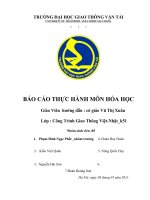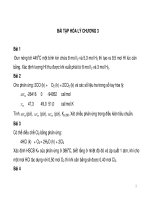Bài tập cân bằng hoá học
Bạn đang xem bản rút gọn của tài liệu. Xem và tải ngay bản đầy đủ của tài liệu tại đây (140.08 KB, 2 trang )
Chapter 15: Applications of aqueous equilibria (CHEM 2B)
15.1 Calculate the pH:
(a) Of a buffer solution consisting of 0.50 M CH3COOH and 0.50 M CH3COONa.
(b) After adding 0.020 mol of solid NaOH to 1.0 L of the buffer solution in part (a).
(c) After adding 0.020 mol of HCI to 1.0 L of the buffer solution in part (a) Ka of
CH3COOH = 1.8x 10-5. (Assume the additions cause negligible volume changes)
15.2 Calculate the pH of a buffer consisting of 0.5 M HF and 0.45 F- (a) after
addition of 0.40 gram of NaOH to 1.0L of the buffer (Ka of HF = 6.8 x 10-4).
15.3 An environmental chemist needs a carbonate buffer of pH 10.00 to study the
effects of the acid rain on limestone-rich soils. How many grams of Na2CO3 must
she add to 1.5 L of freshly prepared 0.20 M NaHCO3 to make the buffer? Ka of
HCO3- is 4.7 x 10-11.
15.4 How would you prepare a benzoic acid-benzoate buffer with pH = 4.25,
starting with 5.0 L of 0.050 M sodium benzoate (C6H5COONa) solution and adding
the acidic component? Ka of benzoic acid (C6H5COOH) is 6.3 x 10-5.
15.5 Calculate the pH during the titration of 40.00 mL of 0.1000 M propanoic acid
(HPr; Ka = 1.3x10-5) after adding the following volumes of 0.1000 M NaOH:
(a) 0.00 mL (b) 30.00 mL (c) 40.00 mL (d) 50.00 mL
15.6 A chemist titrates 20.00 mL of 0.2000 M HBrO (Ka = 2.3xl0-9) with 0.1000 M
NaOH. What is the pH (a) before any base is added; (b) when [HBrO] = [BrO-]; (c)
at the equivalence point; (d) when the moles of OH- added are twice the moles of
HBrO originally present? (e) Sketch the titration curve.
15.7 (a) Lead(II) sulfate (PbSO4) is a key component in lead-acid car batteries. Its
solubility in water at 25°C is 4.25x10-3 g/100 mL solution. What is the Ksp of
PbSO4? (b) When lead(II) fluoride (PbF2) is shaken with pure water at 25°C, the
solubility is found to be 0.64 g/L. Calculate the Ksp of PbF2.
15.8 When powdered fluorite (CaF2) is shaken with pure water at 1 8°C, 1.5xl0-4 g
dissolves for every 10.0 rnL of solution. Calculate the Ksp of CaF2 at 18°C.
15.9 Calcium hydroxide (slaked lime) is a major component of mortar, plaster, and
cement, and solutions of Ca(OH)2 are used in industry as a cheap, strong base.
Calculate the solubility of Ca(OH)2 in water if the Ksp is 6.5x10-6.
Nguyen Tien Thao, Faculty of Chemistry, Hanoi College of Science, VNU
19 - Le Thanh Tong, Hoan Kiem, Hanoi, Vietnam. Email:
1
15.10 A suspension of Mg(OH)2 in water is marketed as “milk of magnesia”, which
alleviates minor symptoms of indigestion by neutralizing stomach acid. The [OH-]
is too low to harm the mouth and throat, but the suspension dissolves in the acidic
stomach juices. What is the molar solubility of Mg(OH)2 (Ksp = 6.5 x 10-10) in pure
water?
15.11 A common laboratory method for preparing a precipitate is to mix solutions
containing the component ions. Does a precipitate form when 0.100L of 0.30 M
Ca(NO3)2 is mixed with 0.200 L of 0.060 M NaF?
15.12 As a result of mineral erosion and biological activity, phosphate ion is
common in natural waters, where it often precipitates as insoluble salts, such as
Ca3(PO4)2. If [Ca2+] = [PO43-] = l.0 x10-9 M in a given river, will Ca3(PO4)2
precipitate? Ksp of Ca3(PO4)2 is l.2x10-29.
15.13 In black-and-white film developing, excess AgBr is removed from the film
negative by "hypo," an aqueous solution of sodium thiosulfate (Na2S2O3), which
forms the complex ion Ag(S2O3)23- . Calculate the solubility of AgBr in (a) H2O; (b)
1.0 M hypo. Kf of Ag(S2O3)23- is 4.7 x 1013 and Ksp of AgBr is 5.0 x 10-13.
15.14 How does the solubility of AgBr in 1.0 M compare with its solubilty in hypo?
Kf of Ag(NH3)2+ is 1.7 x 107.
15.15 Does any solid Cu(OH)2 form when 0.075 g of KOH is dossolved in 1.0 L of
1.0 x 10-3 M Cu(NO3)2?
15.16 Find the pH and volume (mL) of 0.0372M NaOH needed to reach the
equivalence point in titrations of
(a) 42.2 mL of 0.0520 M CH3COOH
(b) 23.4 mL of 0.0390 M HNO2
15.17 Find the solubility of AgI in 2.5 M NH3 (Ksp of AgI = 8.3 x 10-17; Kf of
Ag(NH3)2+ = 1.7x107)
15.18 Copper (I) bromide has a measured solubility of 2.0 x10-4 mol/L at 25°C.
Calculate its Ksp value.
15.20 A solution is prepared by adding 750.0 mL of 4.00 x10-3 M Ce(NO3)3 to
300.0 mL of 2.00 x 10-2 M KIO3. Will Ce(IO3)3 (Ksp = 1.9 x10-10) precipitate from
this solution?
Additional problems:
Chapter 15: 51, 53, 55, 57, 59, 61, 63, 65, 67, 69, 71, 73, 75, 77, 81, 83, 85, 87
All students must complete at leat ….%,
Deadline: …
Nguyen Tien Thao, Faculty of Chemistry, Hanoi College of Science, VNU
19 - Le Thanh Tong, Hoan Kiem, Hanoi, Vietnam. Email:
2









